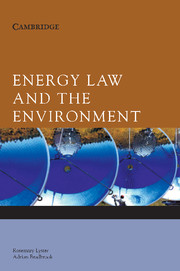Book contents
- Frontmatter
- Contents
- List of figures & tables
- Table of cases
- Table of statutes
- Preface
- 1 Overview of energy production and use in Australia
- 2 Energy technologies and sustainable development
- 3 Energy, international environmental law and sustainable development
- 4 Predicting the RPP for any given year
- 5 Sustainable energy in the Australian electricity and gas sectors
- 6 State government initiatives on energy and the environment
- 7 A sustainable energy law future for Australia
- Appendix A Draft non-legally binding Statement of Principles for a Global Consensus on Sustainable Energy Production and Consumption
- Appendix B Draft Protocol on Energy Efficiency and Renewable Energy to the United Nations Framework Convention on Climate Change
- Index
6 - State government initiatives on energy and the environment
Published online by Cambridge University Press: 05 June 2012
- Frontmatter
- Contents
- List of figures & tables
- Table of cases
- Table of statutes
- Preface
- 1 Overview of energy production and use in Australia
- 2 Energy technologies and sustainable development
- 3 Energy, international environmental law and sustainable development
- 4 Predicting the RPP for any given year
- 5 Sustainable energy in the Australian electricity and gas sectors
- 6 State government initiatives on energy and the environment
- 7 A sustainable energy law future for Australia
- Appendix A Draft non-legally binding Statement of Principles for a Global Consensus on Sustainable Energy Production and Consumption
- Appendix B Draft Protocol on Energy Efficiency and Renewable Energy to the United Nations Framework Convention on Climate Change
- Index
Summary
In this chapter, the initiatives of State governments in Australia in curbing rising greenhouse gas emissions, promoting renewable energy technologies and establishing energy efficiency programs are reviewed. The chapter does not comprehensively cover all initiatives in every State and Territory but is rather indicative of the types of schemes being adopted by this level of government in Australia. One of the interesting dynamics which is emerging is that the State governments are adopting legal measures to move towards a domestic greenhouse gas emissions trading scheme, in the absence of any leadership from the Australian government. They have also all, to varying degrees, adopted greenhouse strategies, established greenhouse offices and sustainable energy agencies, and committed themselves to renewable energy strategies.
Greenhouse gas initiatives
Profile of State greenhouse gas emissions
In June 2005, the Australian Greenhouse Office (AGO) released a paper entitled State and Territory Greenhouse Gas Emissions – An Overview. It is the latest available estimate of emissions from the States and Territories and figures are taken from the National Greenhouse Inventory documenting emissions for 2002. Total emissions in Australia amounted to 541.8 million tonnes. The breakdown is as follows:
New South Wales: 151.5 million tonnes (Mt) = 28%
Queensland: 145.1 Mt = 26.8%
Victoria: 117.0 Mt = 21.6%
Western Australia: 70.4 Mt = 13.0%
South Australia: 30.9 Mt = 5.7%
Northern Territory: 17.7 Mt = 3.3%
Tasmania: 7.2 Mt = 1.3%
ACT: 1.3 Mt = 0.2%.
Emissions from the Stationary Energy sector, including production of electricity and other direct combustion of fossil fuels (other than transport), account for 48% of national greenhouse gas emissions.
- Type
- Chapter
- Information
- Energy Law and the Environment , pp. 139 - 181Publisher: Cambridge University PressPrint publication year: 2006



